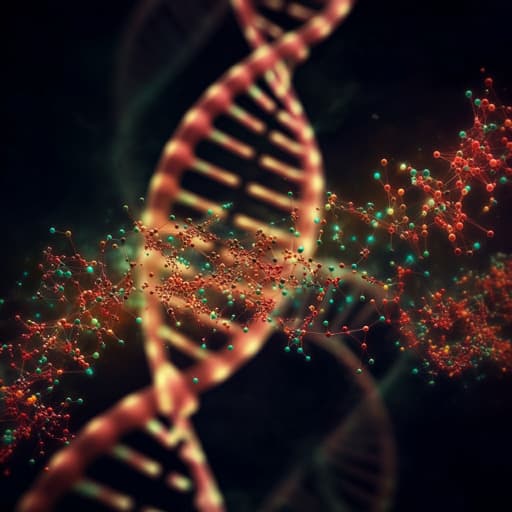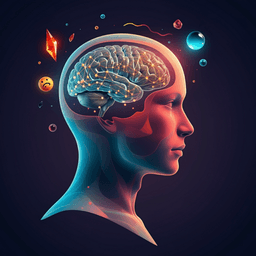
Biology
Can Deep Learning Crack the Genetic Code? A Data-Driven Approach
M. Joiret, G. Gianini, et al.
This groundbreaking study explores how neural networks can crack the genetic code mapping between codons and amino acids, revealing that millions of codon-amino acid pairs are essential for high accuracy. Conducted by a team of experts, including Marc Joiret and Gabriele Gianini, this research highlights the potential of deep learning to efficiently learn biological complexities.
~3 min • Beginner • English
Introduction
The study explores whether Deep Learning can autonomously rediscover the genetic code mapping, providing a pedagogical showcase to address the AI “black box” problem under controlled data quality and availability. Deep Learning (DL) can learn directly from raw data but typically needs large, high-quality datasets. In omics, challenges include interpretability and heterogeneous data quality. Here, the genetic code offers a non-black-box target: the learned rules are causally known, enabling transparent validation and fostering trust. The work frames genetic translation as a language translation task (RNA triplet codons to single-letter amino acids) with a degenerate code. It aims to (i) evaluate whether neural networks can re-derive the complete codon–amino-acid dictionary, (ii) compare architectures and preprocessing, (iii) estimate minimal data required for unequivocal deciphering (including rare stop codons), and (iv) assess benefits of codon embeddings and class-imbalance weighting.
Literature Review
Prior work demonstrates DL’s capacity to learn complex omics features and predict gene function, structure, phenotypes, and outcomes (Zhang et al., Eraslan et al., Munir et al., Rajkomar et al., Shen et al.). DL has been applied in precision medicine by integrating omics with imaging and clinical data (Martorell-Marugan et al.). Nonetheless, challenges persist: interpretability (“black box”) and the need for large, curated datasets. In NLP and bioinformatics, embeddings (word2vec, FastText/FastDNA) and DNA/protein embeddings (DNABERT) capture semantic similarities; recent work (Bonizzoni et al.) proposes training-free embedding methods leveraging combinatorial properties (Lyndon factorizations). RNN theoretical foundations (Siegelmann & Sontag), LSTM/GRU advances, encoder–decoder, VAEs, transformers, and attention mechanisms (Vaswani et al.) have improved sequence modeling, though long-range context methods were not required here. Hidden Markov models are classically used to detect coding regions (Jones & Pevzner). This study positions itself as a pedagogical, controlled benchmark for DL on a well-understood biological mapping rather than proposing new sequence-modeling theory.
Methodology
Task: Learn a mapping from 64 RNA codons (3-grams over A,U,C,G) to 21 output classes (20 amino acids + stop), accommodating degeneracy (many-to-one mapping).
Data: Homo sapiens only. Raw transcriptome (≈69,768 mRNAs; ~23,000 genes) from NCBI/Ensembl was curated to extract full open reading frames (ORFs) starting with AUG, ending with UAA/UAG/UGA, and lengths multiple of three; UTRs and frameshifts were excluded; only mature spliced transcripts were used. For each ORF, the ground-truth protein sequence was generated. Totals: ~83.7M nucleotides, ~27.9M codons and amino acids. Data were split 90% train / 10% test; batch size 64.
Preprocessing/Tokenization: Two One-Hot Encoding (OHE) strategies for inputs: (i) 64-bit OHE at codon level (vocabulary size 64); (ii) 12-bit OHE as concatenation of three nucleotide 4-bit OHEs (3×4). Targets used 21-bit OHE. Optional codon embedding layer with learnable weights: d=2 (for interpretable 2D semantics) and d=10 (denser representations), placed before the classifier.
Architectures: Compared fully connected multilayer perceptrons (MLPs), vanilla RNN (Elman), GRU, and LSTM. MLPs varied in depth (1–2 hidden layers) and width (64, 128, 1024). RNN/GRU/LSTM used two stacked layers with hidden sizes 64 or 256. Initialization for recurrent models enforced orthogonality of hidden states to mitigate vanishing/exploding gradients. MLPs were linear (no hidden activations) except for Softmax output; for MLPs with embeddings, tested ReLU and tanh in hidden layers. RNN/GRU/LSTM used tanh (by construction).
Training: Optimizer Adam; learning rate 0.05 (MLP) and 0.005 (RNN/GRU/LSTM). Epochs: 10–50. Loss: multinomial cross-entropy over 21 classes. Accuracy measured via argmax agreement. Deciphering success was defined as a complete and unequivocal genetic code table (including rare stop codons). Class-imbalance mitigation: optional class weights inversely proportional to amino acid frequencies (from human proteome), applied in the cross-entropy loss to emphasize rare classes. Hardware: single NVIDIA Quadro P320 GPU; per-training runs ranged ~9 minutes to >3 hours, depending on model and epochs. Dynamic heatmaps monitored softmax outputs per codon during training.
Key Findings
- Minimal data and architecture effects (from Table 1 and figures):
- Best without weights: Deep linear MLP with two hidden layers (sizes 64 and 1024) achieved complete deciphering after 8 epochs using ~4.03 million codon/amino acid pairs (MLP64, 2 hidden layers: 64×64×1024×21; 8 epochs; 4,032,000 pairs).
- Shallow MLPs required far more data: 1 hidden layer (64 units) needed 39–40 epochs and ~21.9–22.5 million pairs (12-bit or 64-bit OHE) to resolve rare codons; some instances still ambiguous at 40 epochs.
- Embeddings improved efficiency when paired with ReLU and sufficient capacity: MLP64 with embedding d=10 and a large hidden layer (1024, ReLU) achieved full deciphering in 17 epochs without weights (~9.22M pairs), and with weights in 2 epochs (~384,000 pairs).
- Embedding d=2 with tanh did not unequivocally decipher rare stop codons within 40 epochs (both with and without weights).
- RNNs (two-layer): with hidden size 256 completed in 22 epochs (~11.90M pairs) without weights; with weights, 17 epochs (~8.83M). Hidden size 64 RNN took ~22 epochs (~12.10M) without weights; 30 epochs (~16.70M) with weights. GRU (64) required 29 epochs (~16.13M); LSTM (64) 40 epochs (~22.46M) and remained ambiguous for rare stops.
- OHE comparison: 12-bit OHE led to faster training loss decrease than 64-bit in training but similar test performance; complete deciphering occurred at epoch 39 (12-bit) vs >40 (64-bit) for shallow linear MLPs.
- Class weighting: Adjusting for amino acid frequency imbalance reduced minimal required training data pairs by roughly 40–65% in many settings, particularly benefiting shallower or lower-capacity MLPs. For very high-capacity networks, weights were less beneficial.
- Activation functions: Nonlinear tanh squashed gradients and slowed learning; ReLU avoided vanishing gradients and improved convergence with embeddings and larger hidden sizes.
- Embedding interpretability: With d=2, synonymous codons clustered in embedding space (e.g., GAU/GAC for Aspartate; GGG/GGA/GGC/GGU for Glycine). With d=10, projected 2D still showed semantic clustering for some amino acids (e.g., most Arg codons), though interpretation was harder.
- Data efficiency vs depth/capacity: Deeper and wider networks were markedly more data-efficient. Minimal data for full deciphering was reduced by >80% comparing deep vs shallow MLPs (e.g., ~4M vs ~22.5M pairs).
- Rare codons and stops: Without weighting, misclassifications most often involved stop codons (UAA, UAG, UGA) and rare amino acids (M, W). Weighting and higher capacity resolved these earlier.
Discussion
The work demonstrates that deep neural networks can rederive the genetic code mapping purely from data, validating the feasibility of data-driven discovery on a known, causally grounded problem. Depth and capacity strongly enhance data efficiency; despite the genetic code being a linear mapping, shallow networks are far less data-efficient than deeper ones. Class-imbalance weighting significantly aids learning of rare amino acids and stop codons, though its benefit diminishes with very high-capacity models. Codon embeddings capture semantic similarity (synonymous codon clustering), providing interpretable intermediate representations. RNN memory for triplet sequences offers limited advantage for this short-context task and, combined with tanh activations, slows convergence relative to linear or ReLU-activated MLPs. Importantly, while the models recover the mapping, they do not reveal underlying biochemical mechanisms (tRNAs, ribosome), highlighting that data-driven inference establishes strong associations but not mechanistic causality. For biomedical applications where data acquisition is costly, favoring deeper architectures can lower data requirements at the expense of computational time and reduced immediate interpretability, suggesting a trade-off. The study provides a benchmark for data requirements in omics-related DL tasks and a pedagogical bridge for the biomedical community regarding AI capabilities and limitations.
Conclusion
Deep learning architectures can efficiently and accurately rediscover the genetic code from mRNA–protein pairs. Network depth and width substantially reduce the minimal training data required for unequivocal deciphering, while class-imbalance weighting accelerates learning of rare codons and stop signals. Codon embeddings provide semantically meaningful representations that align with synonymous codon groups. The study quantifies the data and architectural trade-offs, offering a practical benchmark for omics DL tasks and a pedagogical example to build trust in AI among biomedical researchers. Future work could extend to contexts requiring longer-range dependencies (e.g., including UTRs, alternative splicing contexts), investigate transformer-based models with attention, and integrate mechanistic models to bridge from associations to causality in biological translation.
Limitations
- The approach recovers mapping associations but not mechanistic causality (e.g., no discovery of tRNA or ribosome roles).
- Restricted to human mature ORFs; untranslated regions, frameshifts, and intron–exon context were excluded, limiting generality to broader transcriptional contexts.
- Some numerical details are architecture- and dataset-specific; generalization to other species or smaller transcriptomes may require aggregating datasets.
- RNN/GRU/LSTM configurations were basic and constrained by tanh activations, potentially underrepresenting their performance with alternative designs.
- Publication text indicates some incomplete numeric reporting (e.g., percentages, epoch ranges) and does not explore modern attention-based models, which might alter data efficiency assessments in extended contexts.
Related Publications
Explore these studies to deepen your understanding of the subject.







